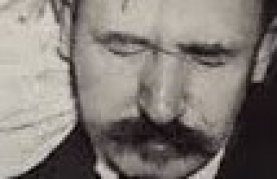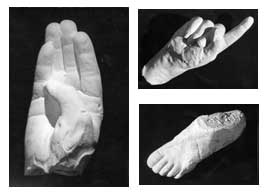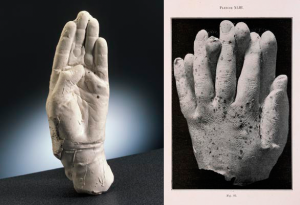
Franek Kluski (1873-1943) was a Polish banker who exhibited psychic abilities and for some years submitted to investigation as a materialization medium. His séances were notable for producing wax moulds of ectoplasmic forms...
Franek Kluski was born Teofil Modrzejewski to middle-class parents in Warsaw, where he spent most of his life. His main profession was banking: by the 1920s he was on the board of one of the main banks in Warsaw. He enjoyed a happy family life and acquired a large circle of friends during a varied career which also included creative writing, journalism and military service.
Kluski never performed publicly as a medium, never made any public references to his mediumship, never profited financially from it, and gave it up after a fairly brief period of intense experimentation. His recorded ‘career’ as a physical medium began in 1918 and lasted, with an interruption during the Russian-Polish war in 1920 when he joined up as a volunteer, until 1925-6.
Although he achieved a brief period of notoriety as a medium (he himself described it as a ‘circus’), his real vocation was that of a man of letters. He achieved considerable success writing for the theatre, had a regular column as the economics correspondent for one of the Warsaw dailies, and wrote occasional articles and poetry. Significantly, he refused to write about his mediumistic experiences, fearing that the kind of sensationalism this would attract would damage his good name...
The only séances with Kluski held in a laboratory were the ones which took place at the International Metapsychic Institute in Paris in 1920, described by Geley in his Clairvoyance and Materialization.There were eleven successful sittings and three in which phenomena were absent or insignificant. With one exception they took place at the IMI laboratory, a room with no windows and with two entrance doors, both of which were locked after the medium and the experimenters had entered. The light used was sufficient to show the outlines of the medium and the experimenters.
The medium sat in an ordinary chair in front of the dark cabinet, which was not used. The controls consisted, essentially, of the medium’s hands being held by the experimenters on his right and left. The experimenters also pressed against the medium’s legs and knees, so that he could not make a move without it being felt. Kluski remained almost perfectly still throughout the séances, only placing his head on the table in front of him or on the shoulder of one of the controllers once he was entranced. His hands would not move at all. Geley stressed the researchers’ certainty that the trick of hand substitution was never attempted, and discusses at length the impossibility of producing the large-scale phenomena even if hand control had been deficient...
The 'Kluski Hands'
A unique feature of the Kluski phenomena was the production of plaster moulds of materialized limbs. These were obtained by the ectoplasmic ‘phantom’ submerging a hand, foot or sometimes part of a face into a bowl of warm paraffin wax and letting the resulting mould set (a process which could be accelerated by dipping it into cold water). Where the impression was of a hand, it narrowed at the wrist, a highly significant detail obtained by the fact of the ‘hand’ – as a temporary ectoplasmic structure – simply dissolving instead of withdrawing from the mould, as a living person would have to do, causing it to break apart.
Figure 1: plaster casts made from wax moulds obtained during sittings

Successful attempts to take ‘glove’ impressions were made from the earliest séances with Kluski. The moulds were occasionally similar to Kluski’s hands; on average three were produced during a single sitting. However, they were so fragile that few survived.
For Geley, the production of intact moulds of hand and wrist stood as a permanent paranormal object, one that could not be created by any normal means...
If Kluski could not have produced the moulds fraudulently during the séance, the next most obvious scenario involving fraud is that moulds of all shapes and sizes were prepared beforehand, and smuggled into the séance room by the medium and his accomplices: this is the explanation for particularly complex moulds offered by Polidoro and Garlaschelli.
However, many reports have detailed description of mould formation: the wax is heard to splash, and within about a minute soft gloves, different in size, character, and arrangement, drop on sitters’ hands, in their laps, or on the table. They tended to be so thin (1mm) and fragile that very few of them survived. Nevertheless, most remained intact sufficiently long for people to feel them when they were warm and soft, continue to hold them, and then examine them closely when they had cooled.
Experiments conducted in France by Gustave Geley, Charles Richet and Count de Gramont at the IMI in Paris in 1920 provide the best picture of how the moulds were obtained. What follows are excerpts from Mario Varvoglis’s account of the procedure:
The sessions took place in low red light, which was sufficient to distinguish the outlines of those present. All sitters locked hands during the sessions… Typically, Kluski’s hands (and not just the wrists) would be held by Dr. Geley on one side, and Charles Richet or Count de Gramont on the other. The experimenters also maintained permanent leg contact with the medium. All contacts were verified before the light was dimmed. Once the session had begun, the controllers would give frequent reports, checking and verbally confirming their certitude that they are holding one of Kluski’s hands.
The system used at the IMI involved a circular tank 30 centimetres in diameter, containing several kilograms of wax that floated on electrically heated water, thus producing a 10-cm deep layer of liquid wax. The system was placed on a table, in the centre of the circle formed by the sitters, 60 centimetres in front of the medium. Rather than using a second bowl for cooling, the IMI researchers preferred to allow the wax moulds to rigidify on their own, this being, as we shall see, a precaution against fraud. Following the sessions, the investigators would pour plaster into the fragile wax moulds, to obtain a more permanent object; once the plaster hardened, they would simply plunge the ensemble into boiling water and strip away the wax layer.
While the olfactory, visual and tactile phenomena came soon after sessions began, it generally took 15 to 20 minutes before any sign appeared that a mould was in the process of forming. The experimenters would first hear the sound of the ‘hand’ dipping into the paraffin, and then feel it touch their own hands, moist with warm wax. It would then be heard dipping in the container again, and finally come out and deposit itself next to them. Once begun, this whole process would evolve quite rapidly - within 1 to 2 minutes. As Geley remarked this was quite surprising, given that paraffin’s normal time to solidify at room temperature is much longer.
December 27th session: Just prior to beginning, Richet and Geley had secretly added a bluish colouring agent to the paraffin. Control of the medium was considered excellent, with controllers regularly checking and verbally reporting ‘I am holding the right hand’, ‘I am holding the left hand’. Splashing sounds were heard about twenty minutes into the session, and one to two minutes later two warm paraffin gloves were deposited next to the controllers. Both wax moulds had precisely the same bluish tint as that of the tank, strongly suggesting that these were indeed created during the séance, and not smuggled in by the medium. An additional control was the weighing of all substance. Prior to the experiment, the paraffin was 3.920 grams, while at the end of the session it weighed 3.800 grams. The two moulds weighed 50 grams, and there was considerable wax scattered near the medium (around 15 grams), on his clothing, and on the floor 3.5 meters away from him (about 25 grams). Insofar as the sum of these weights correspond very closely to the initial weight, this further establishes that the wax gloves were produced during the session. Finally, it should be mentioned that the wax moulds were less than a millimetre thick (thinner than a sheet of paper).
We also have a detailed account by Hewat McKenzie, the principal of the British College of Psychic Science, who described the experiment which he himself conducted with Kluski at Kluski’s apartment in May 1922:
The medium’s right hand was held by Mrs McKenzie’s left, and the medium’s left hand was held by another sitter. The five wax gloves... were produced within about five minutes of the time when the first was laid lightly upon my hand and coat sleeve, and while still in the hot molten state. As it was laid upon my hand several drops of hot wax splashed from it upon my clothes. The remaining four were placed upon the table in close succession, at about one minute interval between each.
The medium, previous to the experiment, was stripped naked and examined by me, in the presence of my interpreter, a gentleman who had never before sat with M. Kluski. The medium then put on another suit of clothes after same had been carefully examined. After the medium and six friends were seated, I was requested to lock the door. A 60-candle power electric lamp illuminated the room for some minutes after the séance began. Soon after this was extinguished, splashing was heard in the molten wax, which was contained in a basin upon the table immediately in front of me, creating a sound similar to what one might expect if a hand or hands were being actively moved amongst the liquid paraffin.
These gloves were without doubt freshly constructed, being soft to the touch when the first one was laid on my arm.
